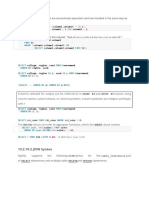0% found this document useful (0 votes)
119 views3 pagesMYSQL Cheat Sheet
MySQL cheat sheet provides the most commonly used MySQL statements that help you practice MySQL more effectively.
Uploaded by
Gary AndrewsCopyright
© © All Rights Reserved
We take content rights seriously. If you suspect this is your content, claim it here.
Available Formats
Download as TXT, PDF, TXT or read online on Scribd
0% found this document useful (0 votes)
119 views3 pagesMYSQL Cheat Sheet
MySQL cheat sheet provides the most commonly used MySQL statements that help you practice MySQL more effectively.
Uploaded by
Gary AndrewsCopyright
© © All Rights Reserved
We take content rights seriously. If you suspect this is your content, claim it here.
Available Formats
Download as TXT, PDF, TXT or read online on Scribd
/ 3



















































































